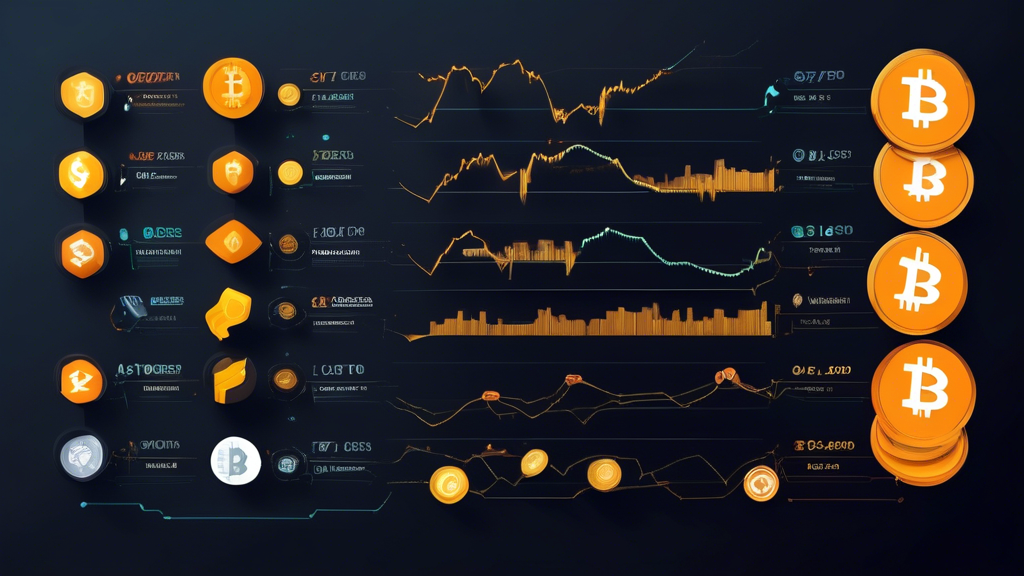Understanding the Volatility of Crypto Markets
The crypto markets have become one of the most dynamic and complex financial landscapes in recent years. With rapid price swings and unpredictable trends, understanding the volatility of crypto markets is essential for both new and seasoned investors. This article aims to shed light on the intricate factors that drive the dramatic fluctuations in the value of cryptocurrencies and provide strategies to navigate this often turbulent market. Whether you are looking to gain insights into market sentiment, scrutinize the impact of technological advancements, or explore strategies to mitigate risks, this comprehensive guide will help you understand the multifaceted nature of crypto market volatility.
Fundamental Factors Influencing Crypto Market Volatility
Various fundamental factors significantly influence the volatility of crypto markets. Market sentiment, often driven by news and social media, plays a crucial role in the price dynamics of cryptocurrencies. Understanding how supply and demand mechanics work in the context of digital assets is equally important. Additionally, technological developments and innovations within the blockchain sphere can lead to market turbulence. Grasping these fundamental elements is imperative for any investor looking to navigate the crypto landscape effectively.
External Factors Affecting Crypto Market Stability
Beyond fundamental factors, external influences such as regulatory policies and economic conditions also critically impact the stability of crypto markets. Changes in government regulations and international policies can either bolster or destabilize market confidence. Economic indicators, including inflation and interest rates, together with global financial market trends, further shape the crypto market’s trajectory. Lastly, geopolitical events and news play an undeniable role in the fluctuation of crypto values. By examining these external factors, investors can better anticipate and react to market changes.
Strategies to Navigate and Mitigate Crypto Market Volatility
To thrive in the volatile environment of crypto markets, investors need robust strategies. Diversifying one’s portfolio and implementing effective risk management techniques can mitigate potential losses. Technical analysis and strategic trading plans are vital tools for traders dealing with volatile markets. Moreover, adopting a long-term investment philosophy can provide resilience against short-term market fluctuations. This section will delve into practical approaches to manage risk and optimize investments in the crypto market.
Fundamental Factors Influencing Crypto Market Volatility
Overview of Market Sentiment
Market sentiment plays a pivotal role in determining the volatility of crypto markets. The perception of value and the collective emotion among investors can significantly impact price fluctuations. Information flows rapidly in the digital age, with news updates, social media, and investor sentiment instantly influencing market behavior.
For instance, a tweet from a high-profile individual or announcement of a partnership involving a major cryptocurrency can cause a surge in demand and rapid price increase. Conversely, negative news such as regulatory crackdowns or security breaches can lead to a swift decline in market prices. Platforms like Twitter, Reddit, and various cryptocurrency forums are instrumental in shaping investor perspectives and can create a herd mentality, where traders collectively move the market based on prevailing sentiment.
Role of Market Supply and Demand
The fundamental economic principle of supply and demand is a critical factor in the volatility of crypto markets. Cryptocurrencies, unlike traditional currencies, have a predetermined supply structure. For example, Bitcoin has a capped supply of 21 million coins, which creates scarcity.
When demand for a cryptocurrency surges, such as during periods of heightened media attention or technological advancements, prices tend to spike due to the limited available supply. Initial Coin Offerings (ICOs) and token burns are other factors that can influence supply, leading to significant market movements.
Additionally, the entry of new investors and large institutional players into the crypto markets can disrupt existing supply and demand dynamics. As more people opt to invest in cryptocurrencies, the demand increases, potentially driving prices up and contributing to market volatility.
Technological Developments and Innovations
The cryptocurrency space is synonymous with rapid technological advancements and innovations that can lead to significant market volatility. Changes in blockchain technology, the introduction of new crypto projects, and updates to existing platforms can all cause turbulence in the market.
For example, major upgrades to a blockchain network, such as Ethereum’s transition from a proof-of-work (PoW) to a proof-of-stake (PoS) consensus mechanism, can create uncertainty and speculation, leading to price fluctuations. Successful implementations of these technological changes can boost investor confidence, while delays, security vulnerabilities, or failures can cause market panic and subsequent price drops.
Furthermore, the emergence of new cryptocurrencies and tokens also contributes to volatility. As innovation within the space continues to introduce alternative assets, the shifting market focus can lead to sharp price movements as capital flows from one project to another.
In summary, understanding these fundamental factors—market sentiment, supply and demand dynamics, and technological developments—is essential for navigating the inherent volatility of crypto markets. By staying informed and aware of how these elements interact, investors can better anticipate potential changes and make more strategic decisions.
External Factors Affecting Crypto Market Stability
Regulatory Environment and Policies
The regulatory environment surrounding crypto markets plays a significant role in their stability. Government regulations, whether through newfound policies or legislative amendments, can cause immediate and often drastic shifts in prices. For example, stricter regulations in major markets like the United States or China can drive investor uncertainty, resulting in massive sell-offs and reduced market confidence.
Regulatory clarity, on the other hand, can have a stabilizing effect by attracting institutional investors who seek well-defined rules and legal assurances. An example of this is the introduction of crypto-friendly policies in countries like Switzerland and Singapore, which have seen positive impacts on their respective crypto markets. It’s crucial for market participants to stay informed about regulatory developments to anticipate how these changes might affect market dynamics. In the ever-evolving world of cryptocurrencies, where regulations can change rapidly, staying updated is paramount to navigate the market effectively.
Economic Indicators and Market Trends
Broader economic conditions have a profound impact on crypto markets. Economic indicators such as inflation rates, interest rates, and the overall health of global financial markets can significantly influence investor behavior. For instance, in times of economic uncertainty or low-interest rates, investors often seek alternative assets, including cryptocurrencies, as potential stores of value or hedges against traditional market downturns.
The global trend towards digital finance and decentralized economies is another economic factor influencing crypto markets. As more financial institutions and technology companies adopt blockchain technology, the legitimacy and acceptance of cryptocurrencies increase, which can lead to more stable market growth. Conversely, negative trends in the global economy, such as recessions or significant market crises, can induce increased volatility as investors liquidate more volatile assets like cryptocurrencies first.
Geopolitical Events and News
Geopolitical events also play a critical role in the stability of crypto markets. Political shifts, international conflicts, and significant governmental actions can cause abrupt market movements. For example, significant global events like Brexit, trade wars between major economies, or sudden changes in leadership can introduce uncertainty in traditional financial markets, spilling over into the crypto sphere.
Additionally, the global discourse around digital currencies can influence the market. Positive news, such as endorsements from influential figures or the adoption of cryptocurrency in major economies, can lead to price surges. Conversely, negative news, such as bans on cryptocurrencies in certain countries or high-profile hacking incidents, can result in rapid and significant declines. Investors in crypto markets need to keep a watchful eye on global news to understand and anticipate potential market impacts.
In conclusion, understanding how external factors such as regulatory environments, economic indicators, and geopolitical events affect crypto market stability is vital. These factors can either contribute to stabilizing the markets or introducing high levels of volatility. By staying informed and adapting to these changes, investors can better navigate the inherent volatility of crypto markets.
Strategies to Navigate and Mitigate Crypto Market Volatility
Diversification and Risk Management
In the unpredictable world of crypto markets, diversification is a cornerstone strategy for mitigating risk. By spreading investments across a variety of cryptocurrencies, investors can reduce the impact of a downturn in any single asset. For instance, holding a mix of established coins such as Bitcoin and Ethereum, along with some promising altcoins, can provide a balanced approach.
Moreover, risk management goes beyond diversification. Investors should set clear stop-loss and take-profit levels to mitigate losses and secure gains. This involves defining the maximum amount of capital they are willing to lose on a single trade and implementing automated triggers to execute trades when these limits are reached. Such disciplined approaches can safeguard an investor’s portfolio against extreme market swings.
Technical Analysis and Trading Strategies
Technical analysis is an essential tool for navigating the volatile crypto markets. By studying historical price data and trading volumes, investors can identify patterns and trends that might predict future movements. Key technical analysis tools include:
- Moving Averages: These indicators smooth out price data to identify the direction of the trend, with common examples being the Simple Moving Average (SMA) and the Exponential Moving Average (EMA).
- Relative Strength Index (RSI): This momentum oscillator measures the speed and change of price movements, helping investors determine overbought or oversold conditions.
- Bollinger Bands: These bands provide a visual representation of volatility and potential breakout points by plotting standard deviations around a moving average.
In addition to these tools, specific trading strategies can be employed to capitalize on market volatility. Swing trading, for instance, involves capturing gains over a few days to several weeks by leveraging the natural ‘swings’ of the market. Another approach, scalping, aims for small, frequent profits over very short time frames, often within hours or minutes.
Long-term Investment Philosophy
Amid the short-term fluctuations and unpredictable nature of crypto markets, adopting a long-term investment philosophy can be a stabilizing force. This approach involves holding onto investments for extended periods, typically years, rather than attempting to time the market. The rationale behind this strategy is rooted in the belief that the broader adoption of blockchain technology and digital currencies will drive sustained growth over time.
One of the key benefits of a long-term strategy is the potential to withstand market volatility. While prices may experience significant short-term dips, historical data has shown that major cryptocurrencies tend to recover and grow over the long haul. Investors who maintain their positions during downturns can potentially benefit from the subsequent recoveries and growth phases.
Additionally, a long-term perspective reduces the influence of psychological biases such as panic selling during market crashes or irrational exuberance during bull runs. By focusing on the underlying fundamentals and future potential of the crypto markets, investors can make more informed and less emotionally driven decisions.
In conclusion, while crypto markets are undeniably volatile, a combination of diversification, robust risk management, technical analysis, strategic trading, and a long-term investment philosophy can help investors navigate and mitigate the risks. By adopting these strategies, investors can better position themselves to benefit from the unique opportunities presented by the dynamic and rapidly evolving world of cryptocurrencies.
Conclusion
In summation, the volatility of crypto markets is a multifaceted phenomenon influenced by a myriad of internal and external factors. Understanding the fundamental aspects that drive market sentiment, supply and demand dynamics, and technological developments allows investors to better grasp the forces at work within these markets. Moreover, recognizing the significant impact of regulatory environments, economic indicators, and geopolitical events provides a broader perspective on market stability.
Investors can implement several strategies to navigate and mitigate the inherent volatility of the crypto markets. Employing diversification and comprehensive risk management strategies can safeguard against extreme market swings. Meanwhile, technical analysis and well-formulated trading strategies offer actionable insights for making informed trading decisions. Lastly, adopting a long-term investment philosophy can help investors to maintain a balanced approach, enduring the fluctuations in pursuit of potential long-term gains.
As the crypto markets continue to evolve, staying informed and adapting one’s strategy to the shifting landscape will be crucial. By comprehensively understanding the volatility of crypto markets and employing effective management techniques, investors can better position themselves to capitalize on opportunities within this dynamic financial ecosystem.



